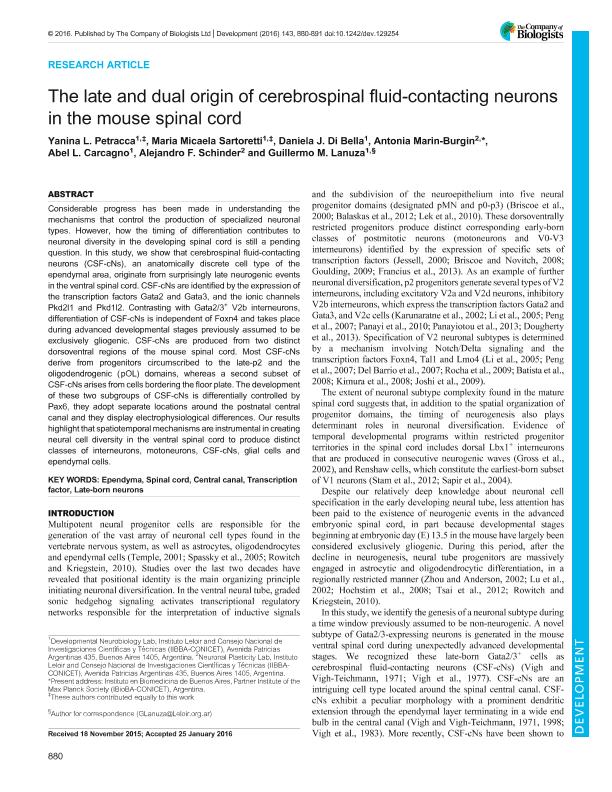Artículo
The late and dual origin of cerebrospinal fluid-contacting neurons in the mouse spinal cord.
Petracca, Yanina Lujan ; Sartoretti, María Micaela
; Sartoretti, María Micaela ; Di Bella, Daniela Jesica
; Di Bella, Daniela Jesica ; Marin Burgin, Antonia
; Marin Burgin, Antonia ; Carcagno, Abel Luis
; Carcagno, Abel Luis ; Schinder, Alejandro Fabian
; Schinder, Alejandro Fabian ; Lanuza, Guillermo Marcos
; Lanuza, Guillermo Marcos
 ; Sartoretti, María Micaela
; Sartoretti, María Micaela ; Di Bella, Daniela Jesica
; Di Bella, Daniela Jesica ; Marin Burgin, Antonia
; Marin Burgin, Antonia ; Carcagno, Abel Luis
; Carcagno, Abel Luis ; Schinder, Alejandro Fabian
; Schinder, Alejandro Fabian ; Lanuza, Guillermo Marcos
; Lanuza, Guillermo Marcos
Fecha de publicación:
02/2016
Editorial:
Company of Biologists
Revista:
Development
ISSN:
0950-1991
e-ISSN:
1477-9129
Idioma:
Inglés
Tipo de recurso:
Artículo publicado
Resumen
Considerable progress has been made in understanding the mechanisms that control the production of specialized neuronal types. However, how the timing of differentiation contributes to neuronal diversity in the developing spinal cord is still a pending question. In this study, we show that cerebrospinal fluid-contacting neurons (CSF-cNs), an anatomically discrete cell type of the ependymal area, originate from surprisingly late neurogenic events in the ventral spinal cord. CSF-cNs are identified by the expression of the transcription factors Gata2 and Gata3, and the ionic channels Pkd2l1 and Pkd1l2. Contrasting with Gata2/3(+) V2b interneurons, differentiation of CSF-cNs is independent of Foxn4 and takes place during advanced developmental stages previously assumed to be exclusively gliogenic. CSF-cNs are produced from two distinct dorsoventral regions of the mouse spinal cord. Most CSF-cNs derive from progenitors circumscribed to the late-p2 and the oligodendrogenic (pOL) domains, whereas a second subset of CSF-cNs arises from cells bordering the floor plate. The development of these two subgroups of CSF-cNs is differentially controlled by Pax6, they adopt separate locations around the postnatal central canal and they display electrophysiological differences. Our results highlight that spatiotemporal mechanisms are instrumental in creating neural cell diversity in the ventral spinal cord to produce distinct classes of interneurons, motoneurons, CSF-cNs, glial cells and ependymal cells.
Palabras clave:
Interneurons
,
Development
,
Csf-Cn
,
Spinal Cord
Archivos asociados
Licencia
Identificadores
Colecciones
Articulos(IIBBA)
Articulos de INST.DE INVEST.BIOQUIMICAS DE BS.AS(I)
Articulos de INST.DE INVEST.BIOQUIMICAS DE BS.AS(I)
Citación
Petracca, Yanina Lujan; Sartoretti, María Micaela; Di Bella, Daniela Jesica; Marin Burgin, Antonia; Carcagno, Abel Luis; et al.; The late and dual origin of cerebrospinal fluid-contacting neurons in the mouse spinal cord.; Company of Biologists; Development; 143; 5; 2-2016; 880-891
Compartir
Altmétricas



